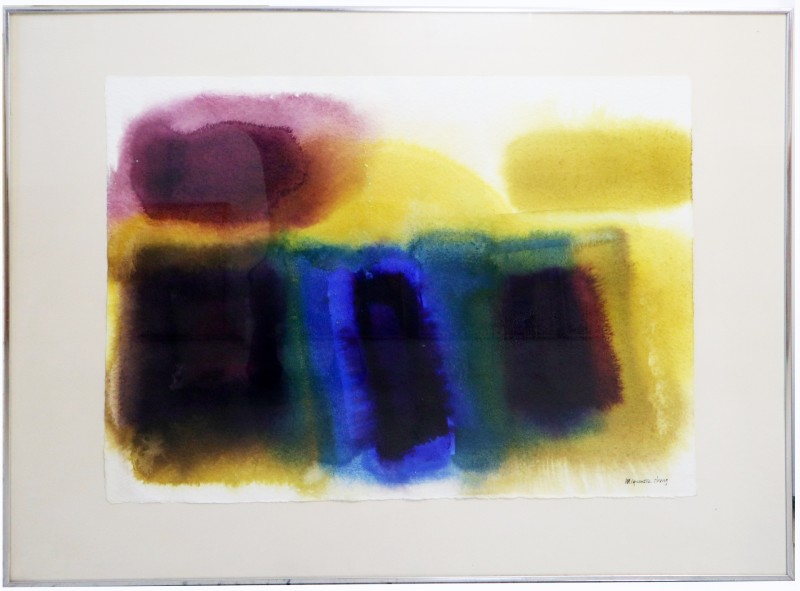Michigan Art Gallery's "Her Joyful Eye" is a calming exhibition of paintings by late U-M prof Mignonette Yin Cheng

If there's ever been a season that’s needed contemplative art, this is it.
Ypsilanti's Michigan Art Gallery has mounted an exhibit that's meant to give us this reflective opportunity.
Mignonette Yin Cheng: Her Joyful Eye, currently on display in-house at the Michigan Gallery—and accessible online—illustrates the fact that contemplation doesn't come by easily. It has to be earned.
As seen in this late University of Michigan art professor emerita's comprehensive retrospective, contemplation took Cheng a lifetime of effort. Based on the evidence at hand, not only was it a matter of artistic discipline but also an iron-clad disposition. There's a cool detachment to Chen's art that focuses her viewer’s eye on the minute observations she makes in her composition.
As the Michigan Gallery's gallery statement tells us, “Born in 1933 near Amoy, China, Cheng received her first training at the Russian Academy of Arts in Shanghai learning traditional Chinese drawing and painting techniques. Arriving in the United States in 1955, her style of painting evolved into a vibrant, gestural expression of her unique background and cultural influence.”
While varying her technique from composition to composition as she experimented, Chen's art is a life-long consolidation of the consequences of what is now called first- and second-generation painterly abstraction. Many 20th-century American modernists oriented to gesturalism took a similar path. But what is of significance in Cheng's art is how she incorporates a characteristic warmth in her work. Additionally, where many American artists were abstracting their work to a gestural geometry, Chen steadfastly maintained a mooring in representation and maintains an elemental empathy that’s largely missing in much mid-20th century American art.
Take as one prime example, Cheng’s undated 40 1/4 x 30 1/4” acrylic and gouache on paper “#106 Landscape.” The lack of date hampers our ability to pinpoint the composition's execution in Cheng's oeuvre, but her facture is reminiscent of the painterly style of first-generation expressionists Mark Rothko and Adolph Gottlieb. The rectilinear orientation of the painting hints of Rothko, but the overlay and diffuse chromaticity of the work is just as much a nod towards Gottlieb. Yet “#106 Landscape” is beholden to neither of these artists as Cheng extends the notion of Gottlieb's “pictographs” and extends it conceptually as her own. Her overlay of secondary colors anchored by the painting’s multihued rectangular blue center vibrates with a complacency that resonates across the composition.

In 1984’s Collage #7 shows Cheng further reducing her geometry through a masterful application of collage technique. Structuring her composition through rectangular gold sheaths that have been subsequently textured by their irregular sheen, Cheng effectively jigsaws her working surface until the lattice of her gold leaf builds an internal harmony. Collage #7 is a demure masterwork whose internal tension holds together the work while the reduction of her gold leaf soothes the eye.
Curator Elizabeth O'Connell's online presentation of Her Joyful Eye is so well crafted and it exploits the web's ability to illustrate far more of the exhibit than would ordinarily be possible. There are multiple examples of Cheng’s work that covers the range of her abstraction as well as illustrate the various sorts of ideography she employed to meld her training with her cultural background and keen observation of mid-20th century gestural art.
Yet these many works are, in my opinion, merely the lead-up to the artworks that Cheng produced later in her career that introduced her to what amounted to a whole new audience in Southeast Michigan—and around the world.
As the gallery statement’s concluding statement tells us, Cheng's “work includes a diverse oeuvre of landscape and still-life, executed plein-air and in-studio, inspired by her extensive travels to England, Scotland, Italy, and throughout Asia.”
It's these watercolor paintings of Italy that particularly galvanized my imagination at the time of their production and amount to what seems to be a turn in Cheng’s art. They show a side of her talent that loosens the ground of her palette by focusing attention on architectural detail. It isn’t quite so much a reorientation as it is a more defined articulation.
These watercolor landscape paintings incorporate all the lessons of Cheng's art through a remarkable integration of her prior work in the service of deceptively nuanced representational composition. One can see her firm grip in the watercolor washes of these landscape works yet there's also a relaxed articulation in her brushstroke that supersedes those earlier works, which leaned more toward the examination of chromaticity and geometry.

One later watercolor on display, 1994’s Lucca, focuses Cheng’s attention on the Cattedrale di San Martino Duomo in the Renaissance-era Tuscan commune near the Ligurian Sea. A tidy 19 1/2 x 14 1/2” masterwork, Lucca is most certainly an abstract composition yet also most certainly seemingly not.
The city walls, the Cattedrale di San Martino, and even the vibrantly variegated cloud play in the composition's interior plane are all inspired by acutely observed detail that’s been crafted through her watercolors. It takes a careful examination of the work to recognize that Cheng has conjured the composition as a series of interlocking watercolor geometry. And such is her acute attention to detail, even the variegated shades of the dominant architectural earth tones seem to reflect what the Michigan Gallery rightly calls her joyful art.
There's no attempt to grab the viewer’s attention in Cheng’s mature work. Her interest in crafting paintings that call for this kind of attention increasingly diminished as she created her art. It’s the rare artist who is comfortable enough in her talent that the entirety of her effort reflects a self-conscious calm.
We can all certainly use this calm right now. It’s good that the Michigan gallery has given us this welcomed respite.
John Carlos Cantú has written on our community's visual arts in a number of different periodicals.
Michigan Art Gallery's “Mignonette Yin Cheng: Her Joyful Eye” will run through January 31, 2021. The Michigan Art Gallery is located at 5138 W. Michigan Ave, Ypsilanti. The exhibit is available Monday-Friday, 9 am–5 pm and by appointment. It is also observable online here. For information, call 734-434-2660.
Related:
➥ "Mignonette Yin Cheng," 2012 book collecting her paintings. [AADL]


































